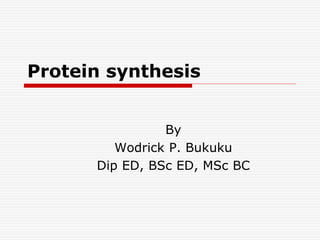
Lecture 3 protein synthesis
- 1. Protein synthesis By Wodrick P. Bukuku Dip ED, BSc ED, MSc BC
- 2. Protein synthesis Protein synthesis is a process of forming protein molecule in the cells The sequence of amino acids in a given protein is determine triplet codes on the DNA molecule In the process the amino acids are linearly arranged into proteins through the involvement of ribosomal RNA, transfer RNA, messenger RNA, and various enzymes.
- 3. Stages of protein synthesis There are four main stages that are involved in protein synthesis. a) Synthesis of amino acid. b) Transcription (formation of mRNA c) Amino acid activation d) translation
- 4. Synthesis of amino acid In plants formation of amino acids occurs in mitochondria and chloroplasts in a series of the following stages a) Absorption of nitrates from the soil b) Reduction of nitrates into amino group c) Combination of amino groups with carbohydrate skeleton e.g. ketogluterate from Kreb’s cycle
- 5. d) Transfer of amino groups from one carbohydrate skeleton to another through the process called transamination.
- 6. Transcription Transcription is the process in which a complementary mRNA copy is made of the specific region of the DNA molecule which code for a polypeptide. During transcription the following events occur; i. A specific region of the DNA called citron unwinds.
- 7. ii. The unwinding of the DNA results in the breaking of hydrogen bonds between base pairs in the DNA double helix and is catalyzed by helicase enzyme. This exposes the bases along the strand.
- 8. Each base along one strand attracts a complementary RNA nucleotide where guanine is paired with cytosine and uracil is paired with adenine. The enzyme called RNA polymerase moves along the DNA adding one complementary RNA nucleotide at a time to newly unwound portion of DNA.
- 9. The region of base pairing between the DNA and RNA is only around 12 base pairs at one time as the DNA reform behind the RNA polymerase. The DNA thus acts as a template against which mRNA is manufactured.
- 10. Many mRNA molecules are made before the RNA polymerase leaves the DNA. The mRNA leaves from the nucleus to cytoplasm through the nuclear pores. The mRNA is then attracted to the ribosome. Along the mRNA are the triplet codes which have been determined by the DNA and each triplet is called codon.
- 11. Amino acid activation Activation is the process by which amino acids combine with tRNA in the presence of ATP. Each type of tRNA binds with a specific amino acid. There are at least 20 types of tRNA and each type of tRNA differs in the composition of a triplet bases called anticodon.
- 12. All tRNA molecules have a common free end which terminates in the triplet. The tRNA molecules with attached amino acids now move towards the ribosomes.
- 13. Translation Translation is the process in which a specific sequence of amino acids is formed in accordance with the codons on the mRNA. A group of ribosomes becomes attached to the mRNA to form a polysome.
- 14. The complementary anticodons of a tRNA-amino acid complex are attached to the first codon (start codon) on the mRNA. The ribosomes acts as a framework which holds the mRNA and tRNA- amino acid complex together until the two have combined to form a peptide between each other.
- 15. Once they have combined the ribosomes moves along the mRNA to hold the next codon-anticodon complex until the third amino acid is linked with the second. Once each amino acid is linked, the tRNA which carries it to the mRNA is released into the cytoplasm, hence free again to combine with its specific amino acid.
- 16. The ribosome continues to move along the mRNA until it reaches one of the non-sense codes at the point the polypeptide is cast off. The polypeptides so formed are assembled into protein.
- 18. The genetic codes Genetic codes are the biochemical instructions that translate the genetic information present as a linear sequence of nucleotide triplets in mRNA into the correct linear sequence of amino acids for the synthesis of a particular peptide chain or protein.
- 19. Features of genetic codes a) The genetic are triplets of bases There are 64 codons. Only 61 triplets or codons code for amino acids. Three of the 64 codons terminate protein synthesis and release the polypeptide from the translation machinery. These triplets are called stop codons or nonsense codons or terminator codons. These are UUA, UAG, and UGA.
- 20. b) The code is a degenerative code. This is because several codons code for the same amino acid. c) It is universal i.e. the triplets codes for the same amino acids in all organisms d) It is non-overlaping i.e. there is no punctuation between each codon
- 21. e) The reading frame is set at the beginning of the gene. Frame shift mutations can be caused by the ADDITION or DELETION of only one or two bases.
- 22. f) The reading of mRNA is always in the same direction 5' to 3' (the same way as transcription and replication).
- 23. THANK YOU FOR LISTENING AND GOD BLESS YOU
